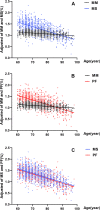Prevalence of sarcopenia under different diagnostic criteria and the changes in muscle mass, muscle strength, and physical function with age in Chinese old adults
- PMID: 36418979
- PMCID: PMC9682713
- DOI: 10.1186/s12877-022-03601-7
Prevalence of sarcopenia under different diagnostic criteria and the changes in muscle mass, muscle strength, and physical function with age in Chinese old adults
Abstract
Background: At present, there are several diagnostic criteria of sarcopenia were used in China, and the diagnostic criteria were not unified. This study aims to investigate the consistency between the latest sarcopenia diagnostic criteria Asian Working Group for Sarcopenia(AWGS 2019) and other common diagnostic criteria. The changes of muscle mass, muscle strength and physical function with age and their effects on the diagnosis of sarcopenia were also analyzed.
Methods: A total of 1009 men aged ≥60 years were enrolled from multiple communities. Skeletal muscle mass index, grip strength and 6 m gait speed were measured. The consistency of AWGS 2019 with other diagnostic criteria was analyzed and the trends of these three indicators were observed. The differences of muscle mass, muscle strength and function among different diagnostic criteria and age groups were evaluated. In addition, the change trends of these three indicators with age were observed.
Results: According to AWGS 2019 diagnostic criteria, the incidence of sarcopenia in male aged 60-69 years, 70-79 years and over 80 years was 1.5%, 9.6% and 33.1%, respectively. AWGS 2019 was highly consistent with other diagnostic criteria (Kappa = 0.66-0.80, P < 0.01), except the Foundation for the National Institutes of Health(FNIH) (Kappa = 0.32, P < 0.01). When AWGSA2019 diagnostic criteria are applied, the prevalence of decreased muscle strength (39.1%) and physical function (46.4%) was significantly higher than that of low muscle mass (35.9%) in the men over 80 years old. Muscle strength (P < 0.01) and function (P < 0.01) decreased at the same rate with age, both of which were more significant than muscle mass (P < 0.01).
Conclusion: AWGS 2019 was highly consistent with other criteria. Maintaining muscle mass should be the focus of attention before age 80, while improving muscle strength and function should be focused after age 80 to prevent disability.
Keywords: Diagnosis; Muscle mass; Muscle strength; Physical function; Sarcopenia.
© 2022. The Author(s).
Conflict of interest statement
The authors declare that they have no conflicts of interest.
Figures



Similar articles
-
Prevalence of sarcopenia in Asian older adults: A comparison of nine diagnostic criteria across different regions.Exp Gerontol. 2025 Apr;202:112721. doi: 10.1016/j.exger.2025.112721. Epub 2025 Mar 1. Exp Gerontol. 2025. PMID: 40032164
-
Comparison of revised EWGSOP criteria and four other diagnostic criteria of sarcopenia in Chinese community-dwelling elderly residents.Exp Gerontol. 2020 Feb;130:110798. doi: 10.1016/j.exger.2019.110798. Epub 2019 Dec 6. Exp Gerontol. 2020. PMID: 31816424
-
The Prevalence of Sarcopenia in Chinese Elderly Nursing Home Residents: A Comparison of 4 Diagnostic Criteria.J Am Med Dir Assoc. 2018 Aug;19(8):690-695. doi: 10.1016/j.jamda.2018.04.015. Epub 2018 Jun 8. J Am Med Dir Assoc. 2018. PMID: 29891183
-
Sarcopenia in Asia: consensus report of the Asian Working Group for Sarcopenia.J Am Med Dir Assoc. 2014 Feb;15(2):95-101. doi: 10.1016/j.jamda.2013.11.025. J Am Med Dir Assoc. 2014. PMID: 24461239
-
The Evolving Landscape of Sarcopenia in Asia: A Systematic review and meta-analysis following the 2019 Asian working group for sarcopenia (AWGS) diagnostic criteria.Arch Gerontol Geriatr. 2025 Jan;128:105596. doi: 10.1016/j.archger.2024.105596. Epub 2024 Jul 31. Arch Gerontol Geriatr. 2025. PMID: 39232423
Cited by
-
Assessing muscular power in older adults: evaluating the predictive capacity of the 30-second chair rise test.Front Aging. 2024 Mar 6;5:1302574. doi: 10.3389/fragi.2024.1302574. eCollection 2024. Front Aging. 2024. PMID: 38510571 Free PMC article.
-
Sarcopenia and sarcopenic obesity among older adults in the nordic countries: a scoping review.BMC Geriatr. 2024 May 13;24(1):421. doi: 10.1186/s12877-024-04970-x. BMC Geriatr. 2024. PMID: 38741067 Free PMC article.
-
Personalised screening tool for early detection of sarcopenia in stroke patients: a machine learning-based comparative study.Aging Clin Exp Res. 2025 Feb 20;37(1):40. doi: 10.1007/s40520-025-02945-5. Aging Clin Exp Res. 2025. PMID: 39979762 Free PMC article.
-
Exploration of Pathogenesis and Cutting-Edge Treatment Strategies of Sarcopenia: A Narrative Review.Clin Interv Aging. 2025 May 23;20:659-684. doi: 10.2147/CIA.S517833. eCollection 2025. Clin Interv Aging. 2025. PMID: 40438271 Free PMC article. Review.
-
Therapeutics for Sarcopenia and Functional Disabilities in Older Adults: A Review of Phase 4 Clinical Trials.Drug Des Devel Ther. 2025 Mar 27;19:2307-2314. doi: 10.2147/DDDT.S507033. eCollection 2025. Drug Des Devel Ther. 2025. PMID: 40165996 Free PMC article. Review.
References
-
- National Bureau of Statistics. Main data of the seventh national population census [EB/OL]. (2021-05-11) [2021-08-15]. http://www.stats.gov.cn/ztjc/zdtjgz/zgrkpc/dqcrkpc/ggl/202105/t20210519_....
-
- Jeon KC, Kim SY, Jiang FL, Chung S, Ambegaonkar JP, Park JH, et al. Prediction equations of the multifrequency standing and supine bioimpedance for appendicular skeletal muscle mass in Korean older people. Int J Environ Res Public Health. 2020;17(16):5847. doi: 10.3390/ijerph17165847. - DOI - PMC - PubMed
Publication types
MeSH terms
LinkOut - more resources
Full Text Sources

